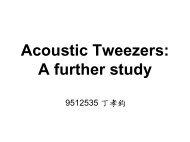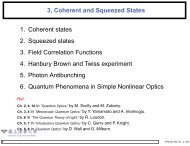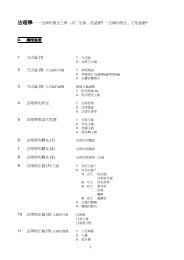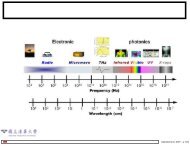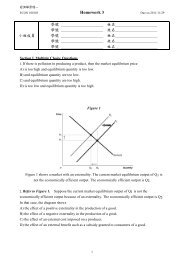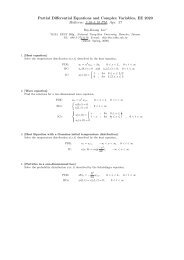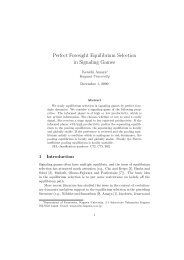Acceleration, Shock and Vibration Sensors
Acceleration, Shock and Vibration Sensors
Acceleration, Shock and Vibration Sensors
Create successful ePaper yourself
Turn your PDF publications into a flip-book with our unique Google optimized e-Paper software.
Chapter 5<br />
Capacitive Accelerometers<br />
Capacitive accelerometers are similar in operation to piezoresistive accelerometers, in<br />
that they measure a change across a bridge; however, instead of measuring a change<br />
in resistance, they measure a change in capacitance. The sensing element consists of<br />
two parallel plate capacitors acting in a differential mode. These capacitors operate<br />
in a bridge configuration <strong>and</strong> are dependent on a carrier demodulator circuit or its<br />
equivalent to produce an electrical output proportional to acceleration.<br />
Several different types of capacitive elements<br />
exist. One type, which utilizes a metal sensing<br />
diaphragm <strong>and</strong> alumina capacitor plates,<br />
can be found in Figure 5.2.12. Two fixed<br />
plates s<strong>and</strong>wich the diaphragm, creating two<br />
capacitors, each with an individual fixed plate<br />
<strong>and</strong> each sharing the diaphragm as a movable<br />
plate.<br />
Figure 5.2.12: Capacitive sensor<br />
When this element is placed in the Earth’s<br />
element construction.<br />
gravitational field or is accelerated due to vibration on a test structure, the springmass<br />
experiences a force. This force is proportional to the mass of the spring-mass<br />
<strong>and</strong> is based on Newton’s Second Law of Motion.<br />
F = ma where F = inertial force acting on spring-mass Eq. 5.2.1<br />
m = distributed mass of spring-mass<br />
a = acceleration experienced by sensing element<br />
Consequently, the spring-mass deflects linearly according to the Spring Equation.<br />
X = F/k where X = deflection of spring-mass Eq. 5.2.2<br />
k = stiffness of spring-mass<br />
The resulting deflection of the spring-mass causes the distance between the electrodes<br />
<strong>and</strong> the spring-mass to vary. These variations have a direct effect on each of the opposing<br />
capacitor gaps according to the following equation.<br />
C2 = AE [ε / (d + X)] <strong>and</strong>,<br />
C2 = AE [ε / (d – X)] where C = element capacitance<br />
AE = surface area of electrode<br />
ε = permittivity of air<br />
Eq. 5.2.3<br />
d = distance between spring-mass <strong>and</strong> electrode<br />
146






